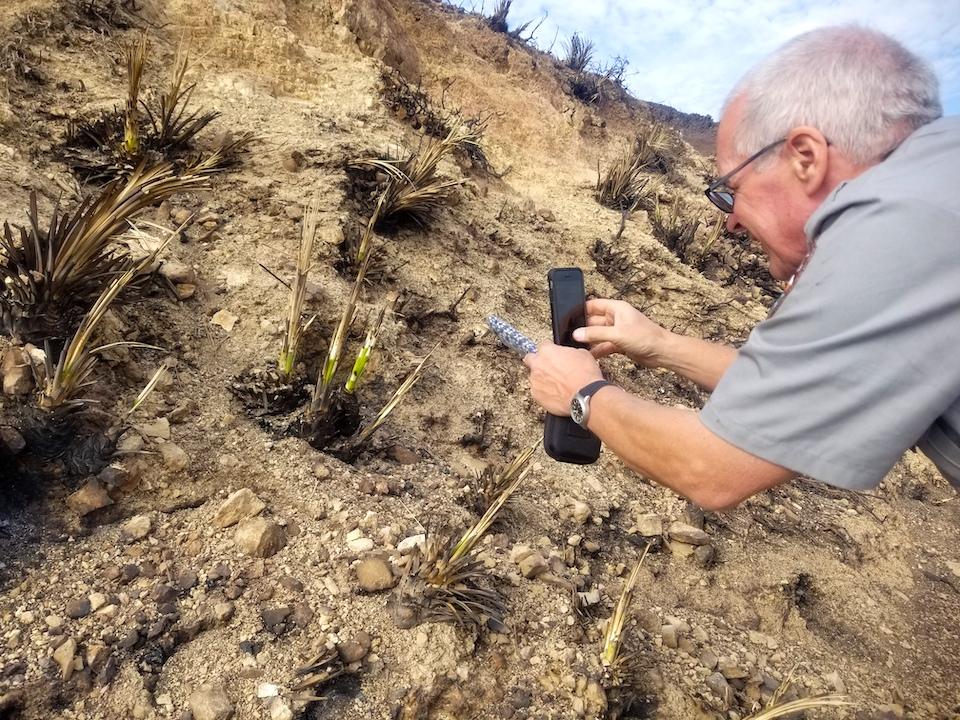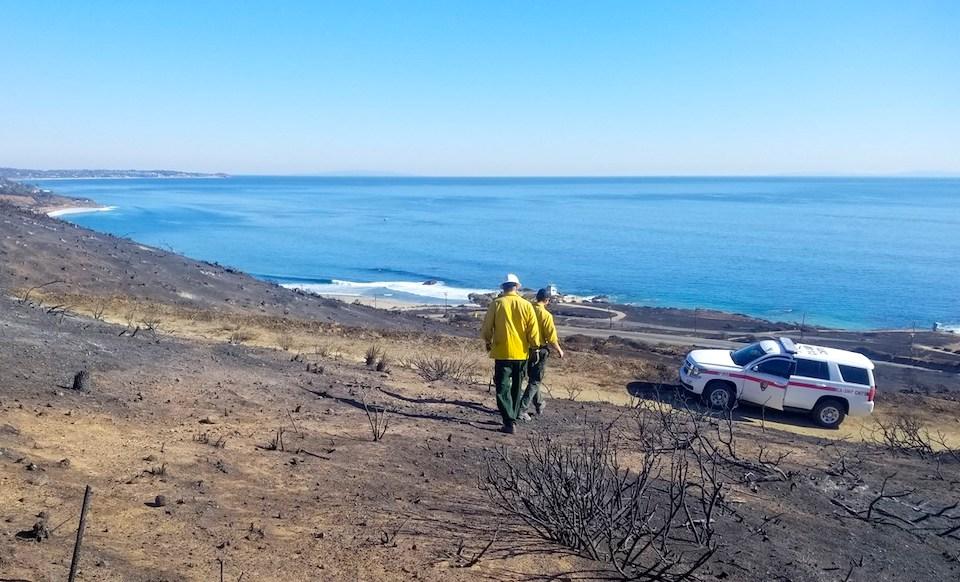
John Tiszler, a supervisory NPS plant biologist who has worked at Santa Monica Mountains National Recreation Area for 22 years, excitedly documents his find/NPS
At least two plant species have been spotted sprouting amidst the charred ash of the Santa Monica Mountains National Recreation Area after the Woolsey Fire burned through almost 100,000 acres and 88 percent of federal land. That’s both good and bad news, National Park Service biologists say.
The good news is that Our Lord’s Candle (Hesperoyucca whipplei), a native yucca known for its dramatic appearance and painful knife-like leaves, is making its presence known all around the Santa Monica Mountains. But similarly flourishing is Giant Cane (Arundo donax), known as one of the worst invasive species globally. This obnoxious, pernicious invasive plant has strong ecological impacts and is tough to kill because it has a very deep underground structure.
“It’s good to see the yucca, bad to see the arundo,” according to John Tiszler, a supervisory National Park Service plant biologist who has worked at Santa Monica Mountains National Recreation Area for 22 years. “The yucca represents the positive possibilities of what can happen after a fire and the arundo represents the negative. The arundo is notorious for prolifically sprouting after fires.”
One of the biggest questions biologists at the park in California have been getting is what happens now – plant-wise? In many areas, the landscape resembles a bleak and depressing moonscape. The chaparral and coastal sage scrub that covered the hillsides and gave the look the Santa Monica Mountains are known for is almost completely gone.
The amount of rainfall, not only during this season but in subsequent ones, and the continuing drought hold the key to whether locals and visitors will see the Santa Monica Mountains as they once were.
“We need to wait and see how much rain comes and in what pattern it comes in,” said Tiszler. “If we get the right amount of rain and in the right patterns, there is no reason why we couldn’t expect to see good regeneration of the native plants, both from seed and by resprouting. If the rains are insufficient or are badly patterned, we may not see the hoped-for native vegetation response and it may open up a window for exploitation of these areas by non-native mustards, grasses and thistles which could ultimately be harmful and inhibit the response of native vegetation.”
Many of the park’s oak trees - valley and live oak - were fully burned by the fire, from top to bottom. It remains to be seen is whether they will ultimately die or resprout with the winter rains. Park scientists say not all will survive, unfortunately. It makes a difference how deeply the burn got inside the tree itself. In this droughted environment, the ones that hold the most promise for survival may be the ones that have the best access to water.

Vegetation is starting to sprout in areas of Santa Monica Mountains NRA that were heavily burned by the Woolsey Fire/NPS
A beloved valley oak tree in Paramount Ranch’s Western Town is drawing attention because it's known as a “witness tree.” From a close proximity, this giant, hulking oak has likely observed all of European settlement in the area and perhaps a not insubstantial portion of Native American habitation; not to mention the numerous weddings, film productions and special events of recent years. It did not fare well in the fire, with much of its bark burned a ghostly white.
“It might have been too severely burned to recover on its own,” said Mark Mendelsohn, a park biologist. "There was a lot of charring on the bark. Nature often surprises us, however."
Park officials say that with the help of a volunteer arborist within the next couple of weeks, efforts will be taken to try strengthen the tree in hopes of enabling its recovery.
What Tiszler and other biologists fear is the burned area will undergo what is called a “vegetation type conversion.” It’s when the dominant shrubland vegetation is replaced by non-native grass and herb plant species. To varying degrees, this has already happened locally in the Santa Monica Mountains and throughout Southern California.
But, as with most things, there may be a silver lining on the horizon. If the rainfall is sufficient and well timed, there could be a strong post-fire herbaceous flora, which could mean wildflowers everywhere next spring. The post-fire flora is a suite of mostly herbaceous plants that can grow in great abundance after a fire. It includes 20-25 percent of the plants occurring in the Santa Monica Mountains; some of these species are only seen after fires.
Other native plants to watch for in the coming weeks include Laurel sumac (Malosma laurina), a deep-rooted plant that has a reputation for being a prolific resprouter, Chamise (Adenostoma fasciculatum), an evergreen shrub, and Greenbark Ceanothus (Ceanothus spinosus). If rains are sufficient, visitors should begin to see shrubs that regenerate only from seed over the next few months, such as Bigpod Ceanohus (Ceanothus megacarpus), the most common shrub in the Santa Monica Mountains.



Comments
I took a walk at Paramount Ranch last Friday (2/8). No change to the large oak in the middle of Western Town, which is not surprising. Other oaks which wee less burned on the perimeter of Western Town appear to be making a comeback. The non-native grasses which were well ]entrenched in the lowlands to the north of Western Town are understandably very green. From a distance the canyon slopes still look dark and foreboding. However, ans one begins to treck up the trail behind Western Town, you can see lots of resprouting occuring from scrub oaks, chamise, laurel sumac, and poison oak. In addition, there are lots of herbacious shrubs sprouting everywhere. Wildflower sproutings are also quite evident. Looking for a silver lining from the devistation is hard, but at least we may see a great wildflower display this spring and recovery will at least start off better than it did after the Springs Fire in Ranch Sierra Vista/Satwiwa and the adjacent State Park.